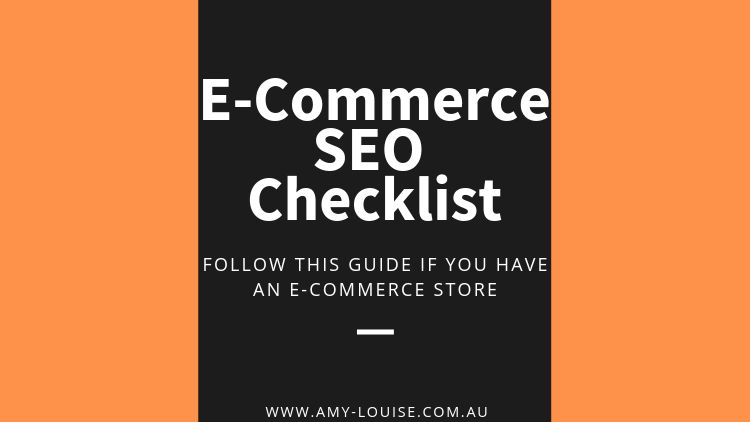
Follow Along With My E-Commerce SEO Checklist
When you look for information on Google and a site that has the information, which one do you choose? If the first site that appears in the search results does not contain your information, you move to the next one until you are satisfied right? Usually, you find what you need within the first five sites. The question here is, do the sites that appear on the following pages not have the information you need? They most probably do but they just do not have the best search engine optimisation and this is even more important when you have an E-Commerce store. This is where the E-commerce SEO checklist comes into play.
Everything revolves around the internet now and Google search engine is the stepping stone of it all. Whatever you want, Google search engine provides you with what is most relevant and most optimised. Now, if it is you providing people with what they want- you might as well provide Google search engine with what it wants and rank high for it.
The process of Search Engine Optimisation does not happen overnight and not with just one tactic. It is, in fact, a very lengthy process with strategies that can build or break your site. You must satisfy a number of aspects to get your desired results. Furthermore, you can be innovative in these tactics as well. But, there are always a few basic strategies, and that brings us to the E-commerce SEO checklist.
What is E-Commerce SEO?
E-Commerce is the buying and selling of products online and SEO means Search Engine Optimisation. Your potential customers search for your products through the various search engines. When they hit that search button the most relevant pages come up in the Search Engine Results Page (SERP). This is where they find a website that sells what they want or at least gets their attention. Search Engine Optimisation means optimising your website so that it appears among the first few websites on the SERP.
Why Is E-Commerce SEO Important?
People rarely click on the websites that appear on the second, third or other pages of the SERP, (unless you are like me and are a Google search results nerd) In fact, people rarely even reach the bottom of the first page. If your E-Commerce store is not among the first few, there is a chance people will never really reach you through the Search Engines.
This is why you need to rank better for Google and then it’s likely you will rank better for the other search engines. Because this is the most widely used tool for searching, let’s focus on what Google needs us to do to rank better.
E-Commerce SEO Checklist:
1- Understand your users- Focus on your content.
The purpose of your website is to provide people with something. So, the first thing to do to be on the positive side is to build a website with top-notch content. Try to keep the quality and relevancy of your content at such a level it caters to most of your ideal customers who will reach for their credit cards. Because we are focusing on E-Commerce SEO we want to target our audience just prior to the purchasing stage of their journey before their mind is made up.
People will only stay on your website if they find something valuable. This will reduce the bounce rate and make you stand out as an expert in your industry if they value your content.
If your content is all about selling your services and not educating, inspiring, or motivating your audience then they won’t stick around long enough to add a product to their shopping cart.
2- Use smart title Tags- Use Keywords to improve E-Commerce SEO
Your E-Commerce store has a specific target audience that it serves and that specific area has very specific search behaviours. The keywords and search phrases that your target audience uses need to be considered here. Track down those keywords and use them in your content, blog posts, banner ads, product descriptions, and file names.
The Title Keyword:
You have to use a different, broad, and relevant keyword in the title or home page. This will let Google know that the product or topic the audience is searching for is relevant to your E-Commerce website. Try and include the brand name in your title as this will give the audience a clearer idea. For example, people don’t just search for a tap usually they will search for a Caroma Tap (Caroma being the brand name).
Page Keywords:
This part of the E-Commerce SEO process is additional to product description SEO, page name etc. It relates to the overall page you want them to land on when they are typing in those relevant search phrases. Let’s use the tap example again. When they search for a Caroma Tap do you want to show them All the Caroma Taps you sell or another brand of taps?
3- Craft long Product descriptions with features and benefits to help with E-Commerce SEO.
There is nothing better than a product description that is packed with value and after you have read it you walk away feeling like a product expert. Just like you need to know your ideal audience, your audience needs to know your products. The easiest way to educate them is to use the product descriptions, after all, they are the ones doing the searching to find out more. Be the solution.
Using pictures and images to help tell a story. This is why more and more websites use pictures and infographics. Luckily, Google has a separate search for only Images and if you optimise those images well enough they can also bring in unexpected customers from the image search.
The best way to optimise your images is to include an Alt-text with a good keyword and/or phrase. So, the moment someone searches for the image, your E-Commerce store comes up.
4- Take a good look at the URL and monitor broken links.
Whatever URL (page address) you are using for your website, it should be meaningful and clear. Apparently, not only the audience but also Google judges you based on the URL name you are using. The audience will not pay much attention to sites that have numbers and meaningless letters as their URL and either does Google.
When someone searches a keyword, Google will deliver the results that are most relevant to that search term. If your product page URL happens to have that keyword in it then Google values this more.
Apart from that, Google also ranks you based on how nicely you are interconnected with other pages. Therefore, build a good interconnection of links and periodically monitor and fix broken links.
5- Use HTTPs.
The Internet is a huge and vulnerable place and all users want to be as safe as possible. Google cares about what users want and users want a safe site. A safe site will be one that encrypts the data that is being transferred. The sites using HTTPs do that and that is why you should build your site up using HTTPs.
Some E-Commerce stores launched before SSL was mandatory, this can have an effect on your organic optimisation when you change from HTTP to HTTPs if it’s not handled properly.
Not only will the users feel safe, with HTTPs but it’s a requirement if you are doing sales on your E-Commerce store.
6- Make sure you create not just curate- Write Blog Posts.
One of the best and most relevant ways to get your products in front of your ideal audience is to blog about it. People will come to your blog to get educated, read industry news, hear your expert opinions and engage with your brand. In fact, the more you blog about relevant topics the more it will help your E-Commerce SEO.
Then when you have this big bucket of content you can start sharing it on social media for more E-Commerce SEO juice.
7- Avoid duplication.
Your content has to be unique, relevant and attractive. If customers find similar content elsewhere, they will likely think you have just copied someone else. Furthermore, Google will not value you either, in fact, it may punish you for duplication. Always make sure you have the least possible matches with other similar sites and if you have to re-write your content, product descriptions, and articles so it is original – just do it, it will be worth it in the end.
8- Structure your website well to leverage SEO for E-commerce
When you visit a website and cannot find what you want even though it’s there, you leave the site right?! You have to make your website an easy experience for visitors. Don’t make it hard for them to shop on your E-Commerce store. Make sure your store has a good, clear design that easily communicates to your visitor what it sells and where they can find it – the design must not distract them from the add to cart button.
Also, link your store and website to other internal pages if it’s relevant. You should be considering who your ideal customer is and how do they prefer to communicate. Do they prefer using Facebook Messenger? Or a Live Web chat, or by sending an email?– either way, structure your E-Commerce site to cater for their contact needs.
In conclusion
It was long ago when just having an online presence was seen as a competitive advantage. Now, it is not enough to just be present online, In order to be seen and known as that go-to solution or expert in your industry, you need someone who knows what they are doing – digital marketing and optimising a website or E-Commerce store for success requires agility and know-how. It’s of the utmost importance that you engage a trustworthy E-Commerce SEO expert as there are a few questionable SEO methods out there that can render your site banned by search engines, which defeats the purpose of SEO. Check out my White hat SEO versus black hat SEO article to learn more.
E-Commerce SEO is not a toy that you want to muck around with and then pack it away again when you’re bored it’s a long-term strategy, using this E-Commerce SEO Checklist will give you a great foundation on what is required to start your efforts.
Should you want a hand with this I can audit your existing site and provide you with an SEO plan or I have tailored done for you SEO packages for all levels that can help you take your E-Commerce or website to the next level. Reach out now via Facebook Messenger.
